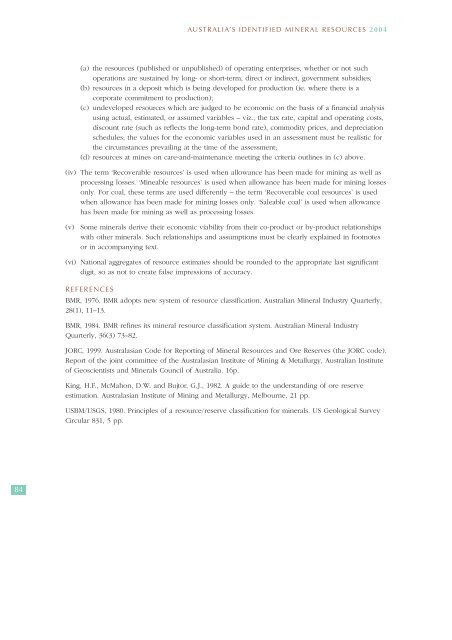australia's identified mineral resources 2004 - Geoscience Australia
australia's identified mineral resources 2004 - Geoscience Australia
australia's identified mineral resources 2004 - Geoscience Australia
Create successful ePaper yourself
Turn your PDF publications into a flip-book with our unique Google optimized e-Paper software.
AUSTRALIA’S IDENTIFIED MINERAL RESOURCES <strong>2004</strong><br />
(a) the <strong>resources</strong> (published or unpublished) of operating enterprises, whether or not such<br />
operations are sustained by long- or short-term, direct or indirect, government subsidies;<br />
(b) <strong>resources</strong> in a deposit which is being developed for production (ie. where there is a<br />
corporate commitment to production);<br />
(c) undeveloped <strong>resources</strong> which are judged to be economic on the basis of a financial analysis<br />
using actual, estimated, or assumed variables – viz., the tax rate, capital and operating costs,<br />
discount rate (such as reflects the long-term bond rate), commodity prices, and depreciation<br />
schedules; the values for the economic variables used in an assessment must be realistic for<br />
the circumstances prevailing at the time of the assessment;<br />
(d) <strong>resources</strong> at mines on care-and-maintenance meeting the criteria outlines in (c) above.<br />
(iv) The term ‘Recoverable <strong>resources</strong>’ is used when allowance has been made for mining as well as<br />
processing losses. ‘Mineable <strong>resources</strong>’ is used when allowance has been made for mining losses<br />
only. For coal, these terms are used differently – the term ‘Recoverable coal <strong>resources</strong>’ is used<br />
when allowance has been made for mining losses only. ‘Saleable coal’ is used when allowance<br />
has been made for mining as well as processing losses.<br />
(v)<br />
Some <strong>mineral</strong>s derive their economic viability from their co-product or by-product relationships<br />
with other <strong>mineral</strong>s. Such relationships and assumptions must be clearly explained in footnotes<br />
or in accompanying text.<br />
(vi) National aggregates of resource estimates should be rounded to the appropriate last significant<br />
digit, so as not to create false impressions of accuracy.<br />
REFERENCES<br />
BMR, 1976. BMR adopts new system of resource classification. <strong>Australia</strong>n Mineral Industry Quarterly,<br />
28(1), 11–13.<br />
BMR, 1984. BMR refines its <strong>mineral</strong> resource classification system. <strong>Australia</strong>n Mineral Industry<br />
Quarterly, 36(3) 73–82.<br />
JORC, 1999. Australasian Code for Reporting of Mineral Resources and Ore Reserves (the JORC code).<br />
Report of the joint committee of the Australasian Institute of Mining & Metallurgy, <strong>Australia</strong>n Institute<br />
of Geoscientists and Minerals Council of <strong>Australia</strong>. 16p.<br />
King, H.F., McMahon, D.W. and Bujtor, G.J., 1982. A guide to the understanding of ore reserve<br />
estimation. Australasian Institute of Mining and Metallurgy, Melbourne, 21 pp.<br />
USBM/USGS, 1980. Principles of a resource/reserve classification for <strong>mineral</strong>s. US Geological Survey<br />
Circular 831, 5 pp.<br />
84

















